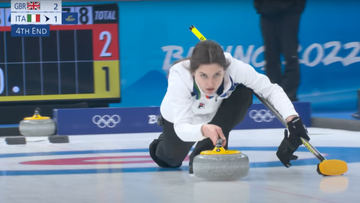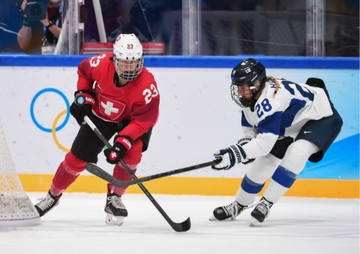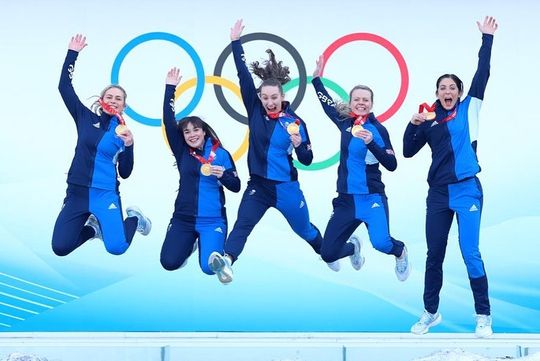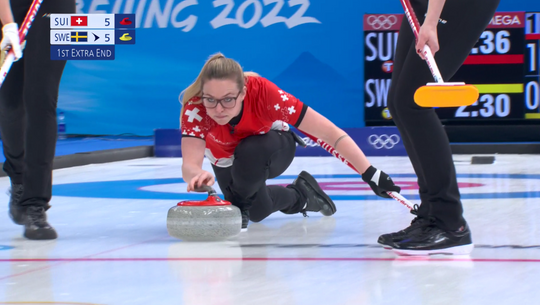The women’s curling competition begins on February 10, and it promises to be exceptional. If you're new to curling or are wondering about what varies between the four-person game and the mixed doubles competition, there are a few key differences.
Curling was first included as part of the Olympic program 1924 and appeared intermittently as a demonstration sport until it was finally permanently added in 1998. That year in Nagano, the legendary Canadian skip Sandra Schmirler added Olympic champion to her illustrious resume, which already included three Scotties championships and three world titles. (The Scotties are the Canadian national women's team curling competition event.) It was the last marquee moment of her important career; she was diagnosed with cancer in 1999 and died at the age of 36 in 2000. If you haven’t seen it before, check out her game winning shot at the 1997 Canadian Olympic Curling trails, simply known as "The Shot."
But the women's competition has been dominated by Sweden since Schmirler's triumph. The nation consistently features on the podium, earning a spot on the podium at every Olympics except at Salt Lake City in 2002. Back-to-back gold medal performances by Sweden's greatest curler, Anette Norberg, and her team in 2006 and 2010 cemented their status. Sweden's golden turn was interrupted by Canada's Jennifer Jones in 2014 but restored by Team Hasselborg, led by then-28-year-old skip Anna Hasselborg, at Pyeongchang in 2018. Team Hasselbourg defeated tournament favourite South Korea to win Olympic glory.
Both Korea and Sweden deserved to play for gold. They were the two best performers of the tournament. However, the final wasn't a classic – more of a slow motion blowout. Korea didn't play badly (as a team they curled 81%) but skip Kim Eun-jung had a few near misses and Sweden capitalized. Korea was held to a single in one and Sweden blanked the second. Hasselborg's team got their deuce in three and then stole singles in ends four and five to lead 4-1 at the break.
The game was over in the seventh, when Sweden scored 3, the first big end Korea surrendered all tournament. Hasselborg needed a draw to the eight-foot and a take-out with her skip stones to net three points. The teams played two more ends, but it was handshakes after the ninth.
Sweden was simply dominant in the final and fully deserved its third gold medal in women's curling. Lead Sofia Mabergs curled a perfect game and second Agnes Knochenhauer curled at 83%. Sweden's back end was simply marvelous; Sara McManus curled at 90% and Hasselborg curled at 94%. That is exceptional curling, and few teams could have matched them.
Looking ahead to this year's competition in Beijing, there are a few teams to watch. The field is much different than it was in 2018, but there will be some familiar faces as well.
Who to Watch
Sweden
Team Hasselborg must be considered one of the favourites in Beijing. The defending Olympic champions currently sit number two in the world rankings and have added two World Championship silver medals and two European Championship gold medals to their name since winning gold in Pyeongchang.
As a fixture on the Grand Slam of Curling (GSOC) tour, Team Hasselborg has had mixed results during the last two seasons, missing out on the podium at the 2021 Worlds with a fourth-place finish. While the final Grand Slam event before the Olympics, the Meridian Open, was cancelled due to the pandemic, the rink heads into Beijing in fine recent GSOC form, having defeated current world number one Tracy Fleury and defended its Boost National title in the November Grand Slam event held in Chestermere, Alberta. The extra end win was the team's sixth GSOC win.
Switzerland
Another favourite for the gold is Switzerland's Team Tirinzoni. They have made regular appearances in playoff rounds at Grand Slam events, and they've also won the last two World Championships (2019 and 2021). Silvana Tirinzoni, who throws third stones, retooled her team after her 2018 Olympic appearance. Alina Pätz, who skipped her own team to gold at the 2015 Worlds, now throws fourth stones for Team Tirinzoni. This is a Swiss super team, and anything less than a podium appearance in Beijing would be disappointing.
Canada
Perennial favourites in any international curling event, Canada will be represented in Beijing by Team Jones, led by legendary skip Jennifer Jones. Beijing marks the first time that Canada will be sending returning teams in the men's and women's events (Team Jones and Team Gushue on the men's side). Team Jones previously represented Canada at the 2014 Olympics in Sochi, beating Sweden's Team Sigfridsson with ease in the final after running the table in the round robin. Jones' undefeated Olympic run was the first time any women's team had achieved that feat at the Olympics.
Jones was unable to defend her title, after losing the 2017 Canadian Curling Trials semifinal to eventual winner Rachel Homan. That didn't stop the Manitoba rink from making 2018 memorable. Jones finished the year with her record-setting sixth Scotties championship as a skip and her second World Championship title.
On top of that, Team Jones has captured 9 GSOC titles as well.
But Team Jones is more than a legendary skip – watch for third Kaitlyn Lawes. Lawes is in Beijing looking for her third Olympic gold after capturing the mixed doubles crown in 2018 with John Morris. Known for her takeout weight, Lawes is just entering her prime and could easily skip a world class team of her own.
You won't see long-time second Jill Officer in Beijing – she retired in 2018. She's been replaced by Jocelyn Peterman; one half of Canada's top mixed doubles team (with partner Brett Gallant). Peterman brings her own impressive credentials in the women’s game to Team Jones. She's won both a Scotties title (2016) and was a runner-up at the trials (2017) as member of Chelsea Carey's team.
For Jones, now 47 and having won everything there is to win in curling, this Beijing tournament could be her farewell from the professional game, especially if it ends at the top of the podium.
Keep an eye on:
Scotland's Team Muirhead is once again representing Great Britain. Team Muirhead had an uneven 2021, finishing in eighth at the worlds but taking home the European championship after defeating Team Hasselborg in the final.
Japan's Team Fujisawa is currently ranked fifth in the world, winning silver at the 2016 worlds, and then earning the country's first Olympic curling medal, bronze, in 2018. 2020-21 was a breakout season for the team on the GSOC tour, making the quarterfinals at both the Champions Cup and the Players' Championship.
Watch out for the dark horse entry from the United States, led by skip Tabitha Peterson. Team Peterson won bronze at the 2021 Worlds and is one of the most offensively-minded women's teams, averaging almost 10 points per game (9.62), leading all top ten teams. What's more impressive is that they average only 5.74 points against per game, the second lowest percentage of that same group. Second Becca Hamilton was also part of my team of the tournament in 2018:
My team of the tournament includes Team USA's Becca Hamilton at lead. Hamilton curled the most of any woman at Pyeongchang, competing in both the mixed doubles tournament and the women's competition. I cannot stress enough how physically demanding and tiring this was for Hamilton. She curled 16 games in two weeks; that just doesn't happen at this level. What's more, she curled well. While you can't quite compare numbers from the mixed game and the four-person game, taken together she curled at 79% in 16 games. After a sometimes rocky mixed tournament, she improved her play in the women's tournament, curling at 85% for second among leads.
Where's the world number one?
Canada's Team Fleury, led by skip Tracy Fleury, are the world's number one ranked curling team by a healthy margin. The team also includes third Selena Njegovan, second Liz Fyfe, and lead Kristin MacCuish. While the team has yet to breakthrough at Canada's national events, their success on the tour has fueled their standing. At Canada's Olympic Curling Trials in November, that long-awaited breakthrough seemed near, when Team Fleury went a perfect 8-0 through the round robin. They had a team percentage of 84% in one of the most difficult curling tournaments in the world to win, with 8 of the 9 teams placing in the top 25 of the world rankings.
Their perfect record earned them a bye to the final and a chance to square off against Team Jones for a chance to represent Canada in Beijing. The teams traded points in a back-and-forth affair, but it was the more experienced Jones who blew it on an open takeout for two and the win in the tenth end to send it to extras.
Fleury, who's never made it to a national final, had an excellent opportunity to seal the victory in the eleventh end but missed her last two shots, with some help from the veteran Jones who refocused and threw two excellent guards with her final two stones. Ultimately Team Jones came away with the victory.
Despite Jones' tenth end gaffe, it's a result that the stats bear out. Except for the lead position, where both MacCuish and Team Jones' Dawn McEwan curled 92 percent, the Jones team out-curled the Fleury team by a wide margin, with an overall advantage for Team Jones at 85 percent to Team Fleury's 78 percent. It was a game where the collective experience of the Jones team was a true advantage. Going into an Olympic tournament, especially one with the unusual circumstances of a pandemic, experience can seem like the much safer bet.






